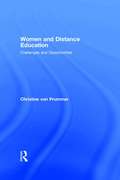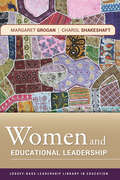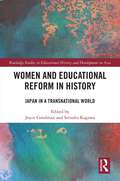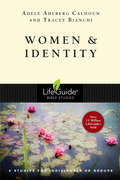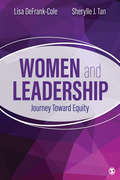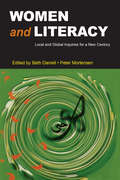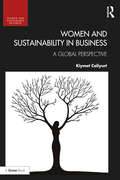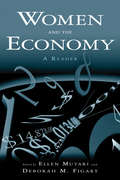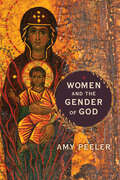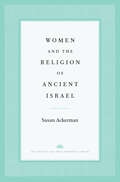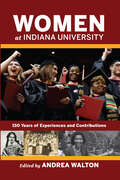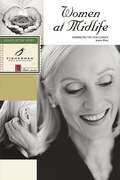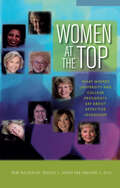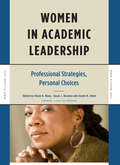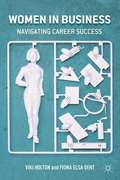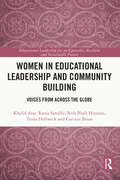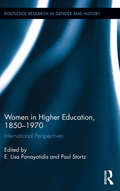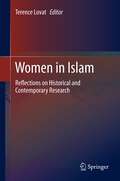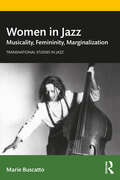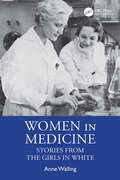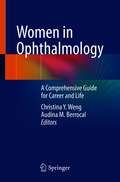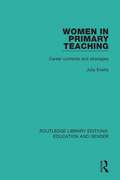- Table View
- List View
Women and Distance Education: Challenges and Opportunities
by Christine von PrummerThis book provides valuable insights into the situation of women in distance education around the world. A wide variety of evidence from different countries supports the conclusion that open and distance learning has the potential to provide equal opportunities in higher and continuing education and that these are currently being missed. The author provides conclusive evidence that distance education, while involving a degree of risk to the stability of families and relationships, etc., nevertheless offers women a chance which, on balance, is worth taking. The author says that it is up to distance education policy makers to provide a framework for women students which will limit the risks and maximise the opportunities. Drawing on fascinating case study material, this book presents vital information for these policy makers.
Women and Educational Leadership
by Charol Shakeshaft Margaret GroganThis groundbreaking book presents a new way of looking at leadership that is anchored in research on women leaders in education. The authors examine how successful women in education lead and offer suggestions and ideas for developing and honing these exemplary leadership practices.Women and Educational Leadership shows how the qualities that characterize women's approaches to leadership differ from traditional approaches?whether the traditional leader is a woman or a man. The authors reveal that women leaders are more collaborative by nature and demonstrate a commitment to social justice. They tend to bring an instructional focus to leadership, include spiritual dimensions in their work, and strive for balance between the personal and professional.This important book offers a new model of leadership that shifts away from the traditional heroic notion of leadership to the collective account of leadership that focuses on leadership for a specific purpose--like social justice. The authors include illustrative examples of leaders who have brought diverse groups to work toward common ground. They also show how leadership is a way to facilitate and support the work of organizational members. The ideas and suggestions presented throughout the book can help the next generation fulfill the promise of a new tradition of leadership.Women and Educational Leadership is part of the Jossey-Bass Leadership Library in Education series.
Women and Educational Reform in History: Japan in a Transnational World (Routledge Studies in Educational History and Development in Asia)
by Joyce Goodman Setsuko KagawaThis unique collection provides critical analyses of Japanese educational history by bringing together gender, transnational, and transcultural perspectives.It illustrates how Japanese, European, and American women educators transcended national borders in seeking to reform and re-shape Japanese education and society in the midst of social and political change from the Meiji era (1868-1912) to 1948 and beyond, including during the American Occupation of Japan. It demonstrates how educational practice from Europe and the United States not only flowed into Japan before and after the First and Second World Wars but also became entangled with Japanese perspectives, as well as with nationalism, colonialism, imperialism, and regionalism, as some Japanese educators sought to reform education for Asian women beyond Japan’s borders. In an increasingly connected world, where, at the same time, opportunities for women’s education in some countries are declining, the volume provides insights for readers into how women educators have co-operated historically across national borders in pursuit of reform in education and society in periods of immense social and political change, including at moments when nationalism and imperialism were in the ascendancy.This volume will be of interest to academics, researchers, and post graduate students in the fields of Japanese history, history of Japanese education, Japanese women’s history, gender perspectives, and transnational and transcultural research. It will also be of interest to readers curious about the history of Asia more broadly.
Women and Identity: 9 Studies For Individuals Or Groups (LifeGuide Bible Studies)
by Adele Ahlberg Calhoun Tracey D. Bianchi®
Women and Leadership Development in College: A Facilitation Resource
by Julie E. Owen Paige Haber-Curran Daniel Tillapaugh Jennifer M. PigzaAs leadership educators shift from teacher- to learner-centered environments, from hierarchical to shared responsibility for learning, and from absolute to constructed ways of knowing, a desire for new inclusive and creative pedagogies is also emerging. This text includes over 40 easy-to-follow modules related to women and leadership development crafted by experienced leadership educators and practitioners. Each module includes learning objectives, detailed instructions, and ideas for adapting the module to diverse learning spaces and audiences. Here are but a few of the critical questions that are addressed in the modules:• How do we make explicit the complexities of power in leadership and in the stories we tell ourselves about feminism and gender in leadership?• How can we interrogate and deconstruct dominant narratives and invite intersectionality? Whose voices are missing or silenced in content and process?• What practices build leadership efficacy and habits of critical self-reflection?• What are the effects of stereotypes, prejudice and discrimination in leadership?• How are learning and leadership both individual and collective processes?• How do we develop critical consciousness and maintain hope in the face of the long arc of structural change?This text is a detailed resource for anyone interested in women and leadership education, whether through a full-length course, a weekend workshop, or a one-time topical session. It also serves as a companion to the book We are the Leaders We’ve Been Waiting For: Women and Leadership Development in College (Owen, 2020).
Women and Leadership: Journey Toward Equity (Leadership: Research And Practice Ser.)
by Sherylle J. Tan Lisa DeFrank-ColeWhile women in the United States account for nearly half the workforce, they continue to encounter unique personal, social, and structural dynamics as leaders. Authors Lisa DeFrank Cole and Sherylle J. Tan explore these dynamics and more in Women and Leadership: Journey Towards Equity. Grounded in leadership theory and research, this text delves into the barriers and challenges women face on their leadership journeys, including stereotypes, bias, inequality, discrimination, and domestic responsibilities. The text includes several chapters devoted to strategies and tools for overcoming obstacles, creating structural change, and moving towards greater equity.
Women and Leadership: Journey Toward Equity (Leadership: Research And Practice Ser.)
by Sherylle J. Tan Lisa DeFrank-ColeWhile women in the United States account for nearly half the workforce, they continue to encounter unique personal, social, and structural dynamics as leaders. Authors Lisa DeFrank Cole and Sherylle J. Tan explore these dynamics and more in Women and Leadership: Journey Towards Equity. Grounded in leadership theory and research, this text delves into the barriers and challenges women face on their leadership journeys, including stereotypes, bias, inequality, discrimination, and domestic responsibilities. The text includes several chapters devoted to strategies and tools for overcoming obstacles, creating structural change, and moving towards greater equity.
Women and Literacy: Local and Global Inquiries for a New Century (Ncte-routledge Research Ser.)
by Beth Daniell; Peter MortensenPath-breaking research on women and literacy in the past decade established conventions and advanced innovative methods that push the making of knowledge into new spheres of inquiry. Taking these accomplishments as a point of departure, this volume emphasizes the diversity—of approaches and subjects—that characterizes the next generation of research on women and literacy. It builds on and critiques scholarship in literacy studies, composition studies, rhetorical theory, gender studies, postcolonial theory, and cultural studies to open new venues for future research. Contributors discuss what literacy is—more precisely, what literacies are—but their strongest interest is in documenting and theorizing women’s lived experience of these literacies, with particular attention to:the diversity of women’s literacies within the U.S., including but not limited to the varying relations that exist among women, literacy, economic position, class, race, sexuality, and education;relations among women, literacy, and economic contexts in the U.S. and abroad, including but not limited to changes in women’s private and domestic literacies, the evolution of technologies of literacy, and women’s experience of the commodification of literacies; andemergent roles of women and literacy in a globally interdependent world. This broad, significant work is a must-read for researchers and graduate students across the fields of literacy studies, composition studies, rhetorical theory, and gender studies.
Women and Sustainability in Business: A Global Perspective (Women and Sustainable Business)
by Kiymet CaliyurtWomen and Sustainability in Business: A Global Perspective, brings together original research from a dozen countries, concerning the issues and challenges facing women in sustainable business. This is a recurrent topic among researchers, regulators, companies and rating agencies. Governments pay special attention to how women impact the economy when shaping their strategies on economic sustainability. Women’s contribution to business is fundamental to creating a sustainable economy, such that businesses try to strengthen ‘women’s presence’ within their organisations, especially on their boards. Today, sustainable companies cannot survive without strategies involving women. Stakeholders, regulators, NGOs and rating agencies track both women-focused strategies and the corporate sustainability reports of companies. Well-designed strategies for women workers help companies to develop their financial and social sustainability initiatives progressively. This book analyses the practice of women in sustainable business, in terms of company performance, social responsibility, board management, entrepreneurship, employment, education, management, social sustainability, environmental politics and technology, from a wide range of diverse, regional perspectives and highlights the differences between the underdeveloped, developing and developed world.
Women and the Economy: A Reader
by Deborah M. Figart Ellen MutariThis reader is designed for use as a primary or supplementary text for courses on women's role in the economy. Both interdisciplinary and heterodox in its approach, it showcases feminist economic analyses that utilize insights from institutionalism as well as neoclassical economics. Including both classic and newer selections from a broad range of areas, each section includes an introduction with background material, as well as discussion questions, exercises, and lists of key terms an further readings.
Women and the Gender of God
by Amy PeelerA robust theological argument against the assumption that God is male.God values women.While many Christians would readily affirm this truth, the widely held assumption that the Bible depicts a male God persists—as it has for centuries. This misperception of Christianity not only perniciously implies that men deserve an elevated place over women but also compromises the glory of God by making God appear to be part of creation, subject to it and its categories, rather than in transcendence of it.Through a deep reading of the incarnation narratives of the New Testament and other relevant scriptural texts, Amy Peeler shows how the Bible depicts a God beyond gender and a savior who, while embodied as a man, is the unification in one person of the image of God that resides in both male and female. Peeler begins with a study of Mary and her response to the annunciation, through which it becomes clear that God empowers women and honors their agency. Then Peeler describes from a theological standpoint how the virgin birth of Jesus—the second Adam—reverses the gendered division enacted in the garden of Eden.While acknowledging the significance of the Bible&’s frequent use of &“Father&” language to represent God as a caring parent, Peeler goes beneath the surface of this metaphor to show how God is never sexualized by biblical writers or described as being physically involved in procreation—making the concept of a masculine God dubious, at best. From these doctrinal centers of Christianity, Peeler leads the way in reasserting the value of women in the church and prophetically speaking out against the destructive idolatry of masculinity.
Women and the Religion of Ancient Israel (The Anchor Yale Bible Reference Library)
by Susan AckermanA synthetic reconstruction of women&’s religious engagement and experiences in preexilic Israel &“This monumental book examines a wealth of data from the Bible, archaeology, and ancient Near Eastern texts and iconography to provide a clear, comprehensive, and compelling analysis of women&’s religious lives in preexilic times.&”—Carol Meyers, Duke University Throughout the biblical narrative, ancient Israelite religious life is dominated by male actors. When women appear, they are often seen only on the periphery: as tangential, accidental, or passive participants. However, despite their absence from the written record, they were often deeply involved in religious practice and ritual observance. In this new volume, Susan Ackerman presents a comprehensive account of ancient Israelite women&’s religious lives and experiences. She examines the various sites of their practice, including household shrines, regional sanctuaries, and national temples; the calendar of religious rituals that women observed on a weekly, monthly, and yearly basis; and their special roles in religious settings. Drawing on texts, archaeology, and material culture, and documenting the distinctions between Israelite women&’s experiences and those of their male counterparts, Ackerman reconstructs an essential picture of women&’s lived religion in ancient Israelite culture.
Women and the Transmission of Religious Knowledge in Islam
by Asma SayeedAsma Sayeed's book explores the history of women as religious scholars from the first decades of Islam through the early Ottoman period. Focusing on women's engagement with hadīth, this book analyzes dramatic chronological patterns in women's hadīth participation in terms of developments in Muslim social, intellectual and legal history. It challenges two opposing views: that Muslim women have been historically marginalized in religious education, and alternately that they have been consistently empowered thanks to early role models such as 'Ā'isha bint Abī Bakr, the wife of the Prophet Muhammad. This book is a must-read for those interested in the history of Muslim women as well as in debates about their rights in the modern world. The intersections of this history with topics in Muslim education, the development of Sunnī orthodoxies, Islamic law and hadīth studies make this work an important contribution to Muslim social and intellectual history of the early and classical eras.
Women at Indiana University: 150 Years of Experiences and Contributions (Well House Books)
by Kelly C. Sartorius Dina Kellams Andrea Walton Tanner N. Terrell Sarah J. Reynolds Angel Cassandra Nathan Stephanie T.X. Nguyen Merylou Rodriguez Ebelia Hernández Angela Bowen Potter Kathleen Surina Grove Nancy Van Chism Mary Giorgio Katherine Badertscher Sara Clark Catherine A. Dobris Lorée B. Wilcox Rachel Jean Turner Jacob Hardesty Laurie Burns McRobbieThe first in-depth look at how women have shaped the history and legacy of Indiana University.Women first enrolled at Indiana University in 1867. In the following years they would leave an indelible mark on this Hoosier institution. However, until now their stories have been underappreciated, both on the IU campus and by historians, who have paid them little attention. Women at Indiana University draws together 15 snapshots of IU women's experiences and contributions to explore essential questions about their lives and impact. What did it mean to write the petition for women's admission or to become the first woman student at an all-male university? To be a woman of color on a predominantly white campus? To balance work, studies, and commuting, entering college as a non-traditional student? How did women contribute to their academic fields and departments? How did they tap opportunities, confront barriers, and forge networks of support to achieve their goals? Women at Indiana University not only opens the door to a more inclusive and accurate understanding of IU's past and future, but also offers greater visibility for Hoosier women in our larger understanding of women in American higher education.
Women at Midlife: Embracing the Challenges (Fisherman Bible Studyguide Series)
by Jeanie MileyMidlife is a time of transitions, some welcome and others not so welcome. Thankfully, the Bible provides principles and guidance for dealing with difficult times--midlife included. In these studies, you'll tap into that wisdom and learn how you can experience God's grace today and move forward with confidence. Whether you're struggling with the challenges of the present, mired down by mistakes in your past, or excited about the prospects of the future, you'll benefit from these important questions and life-enhancing answers for Women at Midlife.From the Trade Paperback edition.
Women at the Top: What Women University and College Presidents Say About Effective Leadership
by Mimi Wolverton Beverly L. Bower Adrienne E. HyleAlthough much has been written about leaders and leadership, we unfortunately know little about the women who fill this particular role. This book—the first in a series that explores women leaders in different contexts—remedies this gap by presenting the reflections of nine women community college, college, and university presidents on what they see as key tenets of leadership, illuminated by pivotal events in their careers.These presidents know the power of words, and in telling their stories through these interviews with the authors, they let us know who they are, what their visions are, and what they value.While they express some differences in their emphases on particular leadership characteristics, they show remarkable unanimity in their beliefs as to which are the most important—competence, credibility, and communication. The participants discuss the growing opportunities for women in higher education administration, without minimizing the barriers that still exist, nor the potential for backlash against powerful and assertive women. They stress the need for women to be very careful about making the correct choices for themselves; to balance personal life and work; and to appropriately prepare for leadership. This book both breaks new ground, and offers guidance for women who aspire to positions of leadership—in any field of endeavor. The Presidents: Gretchen M. Bataille, University of North Texas, Denton, TexasBarbara Douglass, Northwestern Connecticut Community College, Winsted, CT Mildred García, California State University, Dominguez HillsCarol C. Harter, University of Nevada, Las VegasMamie Howard-Golladay, Sullivan County Community College, Loch Sheldrake, NYMartha T. Nesbitt, Gainesville State College, Gainesville, GeorgiaPamela Sue Shockley-Zalabak, University of Colorado, Colorado SpringsBetty L. Siegel, Kennesaw State University, Kennesaw, GAKaren Gayton Swisher, Haskell Indian Nations University, Lawrence, KS Each confronts her world with grace, her work with passion, and her life with enthusiasm. The Series: Pathways to Leadership is a series about successful women who have reached the pinnacle of their careers. It features stories about extraordinary women who have found paths to success—whether it’s leading a college or university or becoming successful scholars in science and engineering or thriving in some other male-dominated arena.
Women in Academic Leadership: Professional Strategies, Personal Choices
by Diane R. Dean Susan J. Bracken Jeanie K. AllenColleges and universities benefit from diversity in their leadership roles and profess to value diversity--of thought, of experience, of person. Yet why do women remain under-represented in top academic leadership positions and in key positions along the academic career ladder?Why don’t they advance at a rate proportional to that of their male peers? How do internal and external environmental contexts still influence who enters academic leadership and who survives and thrives in those roles? Women in Academic Leadership complements its companion volumes in the Women in Academe series, provoking readers to think critically about the gendered nature of academic leadership across the spectrum of institutional types. It argues that leadership, the academy, and the nexus of academic leadership, remain gendered structures steeped in male-oriented norms and mores. Blending research and reflection, it explores the barriers and dilemmas that these structures present and the professional strategies and the personal choices women make in order to successfully surmount them. The authors pose questions about how women leaders negotiate between their public and private selves. They consider how women develop a vital sense of self-efficacy along with the essential skills and knowledge they need in order to lead effectively; how they cultivate opportunity; and how they gain legitimacy and maintain authenticity in a male-gendered arena. For those who seek to create an institutional environment conducive to equity and opportunity, this book offers insight into the pervasive barriers facing women of all colors and evidence of the need for a more complex, multi-dimensional view of leadership. For women in academe who seek to reach their professional potential and maintain authenticity, it offers encouragement and a myriad of strategies for their growth and development.
Women in Business
by Viki Holton Fiona Elsa DentMuch has been written about equal opportunity issues but little has been published about how organisations might provide more structure and support to ensure women's progress to the most senior business levels. This book looks at the career experiences of a group of women managers and consider what helps, and what still hinders their progress.
Women in Educational Leadership and Community Building: Voices from across the Globe (Educational Leadership for an Equitable, Resilient and Sustainable Future)
by Khalid Arar Rania Sawalhi Rida Blaik Hourani Trista Hollweck Corinne BrionThis book foregrounds the voices of women in educational leadership to draw on the power of diverse perspectives and to create an environment that better embraces a broad range of leadership styles. Chapters explore formal and informal female educational leadership practices, and examine the methods and approaches used by successful female leaders across West Africa, the Middle East, Europe, and Australia. The book examines how best to humanize educational leadership in a way that invests in the unique skills and talents that female leaders’ possess, and identifies a leadership model that is situated within a range of intersecting theoretical frameworks that revolve around collective leadership, transformation theories and community partnerships. In doing so, the book elevates education into the sphere of comprehensiveness, inclusion, equity, sustainability, and social justice. By sharing the lived experience of female leaders using a multi-perspective narrative approach, the book develops and hones exemplary educational leadership and community-engaged practices for the good of all. This volume will be key reading for scholars, doctoral students, and researchers engaged in fields such as education policy, women’s studies, and international and comparative education among others.
Women in Higher Education, 1850-1970: International Perspectives (Routledge Research in Gender and History)
by E. Lisa Panayotidis and Paul StortzThis edited collection illustrates the way in which women’s experiences of academe could be both contextually diverse but historically and culturally similar. It looks at both the micro (individual women and universities) and macro-level (comparative analyses among regions and countries) within regional, national, trans-national, and international contexts. The contributors integrally advance knowledge about the university in history by exploring the intersections of the lived experiences of women students and professors, practices of co-education, and intellectual and academic cultures. They also raise important questions about the complementary and multidirectional flow and exchange of academic knowledge and information among gender groups across programmes, disciplines, and universities. Historical inquiry and interpretation serve as efficacious ways with which to understand contemporary events and discourses in higher education, and more broadly in community and society. This book will provide important historical contexts for current debates about the numerical dominance and significance of women in higher education, and the tensions embedded in the gendering of specific academic programs and disciplines, and university policies, missions, and mandates.
Women in Islam
by Terence LovatThe role of women in Islamic societies, not to mention in the religion itself, is a defining issue. It is also one that remains resistant to universal dogma, with a wide range of responses to women's social roles across the Islamic world. Reflecting this heterogeneity, the editor of this volume has assembled the latest research on the issue, which combines contemporary with historical data. The material comes from around the world as well as from Muslim and non-Muslim researchers. It takes in work from majority Muslim nations such as Bangladesh, Iran, Iraq, Lebanon, Pakistan, Palestine, Tunisia and Turkey, as well as countries with troubled interfaith relations such as India and Israel. Nations with minority Muslim populations such as France, the UK, Canada and Australia, are also represented. The work also features varying Islamic sub-groups such as the two main ones, Sunni and Shi'a, as well as less well known populations such as the Ismaili Muslims. In each case, the work is underpinned by the very latest socio-theological insights and empirical data.
Women in Jazz: Musicality, Femininity, Marginalization
by Marie BuscattoWomen in Jazz: Musicality, Femininity, Marginalization examines the invisible discrimination against female musicians in the French jazz world and the ways in which women thrive as professionals despite such conditions. The author shines a light on the paradox for women in jazz: to express oneself in a "feminine" way is to be denigrated for it, yet to behave in a "masculine" manner is to be devalued for a lack of femininity. This masculine world ensures it is more difficult for women to be recognized as jazz musicians than it is for men – even when musicians, critics and audiences are ideologically opposed to discrimination. Female singers are confined by the feminine stereotypes of their profession, while female instrumentalists must comport themselves into traditionally masculine roles. The author explores the academic and professional socializations of these musicians, the musical choice they make and how they are perceived by jazz professionals as a result. First published in French by CNRS Editions in 2007 (and later reissued in paperback in 2018, with the author’s postscript that "nothing much has changed"), Women in Jazz: Musicality, Femininity, Marginalization expands the conversation beyond the French border, identifying female jazz musicians as a discriminated minority all around the world.
Women in Medicine: Stories from the Girls in White
by Anne WallingIn telling the history of women in medicine, the pioneers (especially the turbulent ones) are rightly remembered and celebrated in books, articles, memorials, awards, names of buildings, and organizations – even in stone statues and memorials. In contrast, the generation who began the transition from minority status to the current numerical equity are seldom memorialized, yet without the efforts of these few determined women in what was unambiguously a male profession, the achievements of these pioneers could easily have withered.This book is written to celebrate this unique generation of women who entered medicine between the Second World War and the early 1970s – determined women who just wanted to be doctors but ended up fundamentally changing the profession. Utilizing oral histories from 37 women who became physicians between 1948 and 1975, these women tell their stories in their own words and provide a valid picture of their experiences throughout their careers that has much resonance for those entering or practicing medicine today. Women in Medicine: Stories from the Girls in White will be of interest to all health professionals or those considering entering health professions, particularly women, and their advisers and supporters, to medical educators, and to medical historians seeking to understand the progress of women in medicine and other professions since the end of WWII.
Women in Ophthalmology: A Comprehensive Guide for Career and Life
by Christina Y. Weng Audina M. BerrocalThere are nearly 24,000 ophthalmologists in the United States, with 500 physicians newly entering the ophthalmology field each year and approximately half of those being women. Although women now represent approximately half of all ophthalmologists, gender disparities remain when it comes to certain subspecialties (e.g., surgical retina), leadership roles (e.g., department chairs), industry involvement (e.g., consultancy and advisory board positions), and even academic publications. There has been a recently heightened interest in female representation in this field which has manifested in several ways (e.g., conferences geared towards women in ophthalmology, non-peer-reviewed publications about women in ophthalmology, and mentorship programs specifically for women). This book is the first of its kind in procuring and disseminating information—pertaining to both career and life—in an organized, concrete, and enduring way. Women in Ophthalmology is a comprehensive collection of chapters primarily written by women in the field of ophthalmology. The book aims to guide others through milestones and challenges women may face during their careers, and shares sound insights into how to deal with unique issues both inside and outside the workplace. Topics that are widely applicable to all who work in ophthalmology are included, such as finding mentors, collaborating within industry, handling work-life balance, and seeking out leadership opportunities. Each chapter combines personal anecdotes with knowledge from leaders in the field which both men and women will find highly valuable.
Women in Primary Teaching: Career Contexts and Strategies (Routledge Library Editions: Education and Gender)
by Julia EvettsOriginally published in 1990. This study investigates the experiences of women in primary teaching and examines the levels of promotion achieved by men and women in the profession. Using extracts from women’s accounts of their own career histories, Women in Primary Teaching analyses both the contexts in which careers are constructed and the strategies that are devised by women pursuing careers. The author examines the extent to which women are faced with a dilemma of dual commitments not experienced by men: the juggling of home and family with teaching work. What effect do interruptions in service and continued family management have on a career? How too do women’s attitudes to promotion differ from men’s and in what manner is promotion sought – if at all? In addressing these questions, this book is interesting to anyone involved in studying women and work as well as practising and student teachers.
